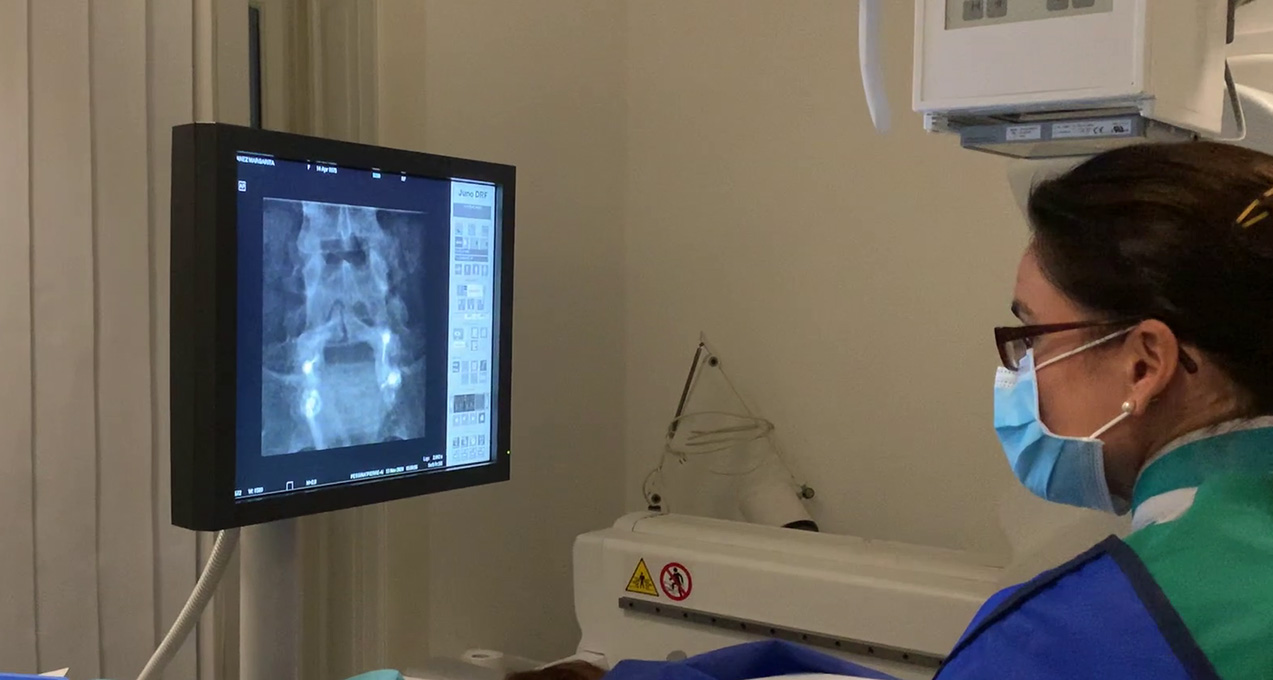
Facet joint infiltration using X-ray or CT
Back pain is currently the main cause of the inability to work. Half of the Swiss population suffers from it several times a week or month. These pains can be very troublesome and spread to the rest of the body.
Injecting the facet joints with a cortisone anti-inflammatory is generally prescribed as a second-line treatment, after conservative treatment has proved insufficient.
What does facet joint infiltration involve?
Before performing this type of procedure, the doctor must first make the diagnosis to ensure that the pain is indeed coming from the facet joints.
The purpose of an infiltration of the inter-apophyseal joints is to reduce “bilateral” lumbar pain by injecting an anti-inflammatory fluid into the joint. This procedure is particularly useful in cases of lower back pain (painful osteoarthritis or lumbago).
Lower back pain refers to pain that appears in the lower back, in the lumbar vertebrae area. It is the most common type of back pain because the lumbar vertebrae are constantly stressed and support a large part of the body’s weight.
Why perform this medical procedure in the radiology department?
This medical procedure is performed in a radiology department so that X-ray and CT images can be taken. As the manipulation being performed is very technical and the area to be injected is very restricted, sometimes with a lot of osteoarthritis, the help of radiological imaging makes it possible to guide the trajectory of the needle with precision. This precision will make it possible to inject the anti-inflammatory in the exact place that is responsible for the pain.
How does facet joint infiltration work?
During the examination, the patient is placed face down on an X-ray table. All of the equipment required for infiltration is prepared by the doctor and the technician. The skin is then disinfected and the procedure is performed under strict aseptic conditions.
Two to four fine needles (thickness of a hair), which are controlled using X-ray imaging, are then placed opposite the facet joints in order to inject the corticosteroid anti-inflammatory.
What are the advantages of this infiltration?
Facet joint infiltration significantly reduces the inflammation that causes pain. This generally leads to an improvement in the patient’s quality of life. This treatment also enables physical and sporting activities to be resumed.
Are there any complications linked to this infiltration?
It is extremely rare for complications to occur following this infiltration technique. When the treatment is performed with great care and precision, in a strictly aseptic environment, then the chances of encountering complications are extremely low. The doctor and technician take every precaution to prevent these risks.
The patient will be offered a safety questionnaire to prevent the risk of allergies or bleeding.
At Medimage, we adhere to infiltration procedures and techniques and we are committed to effectively relieving our patients while ensuring their safety.
What are the results?
It may take 5 to 10 days for the patient to feel relief from the lower back pain. In the 48 hours following the infiltration, it is advisable to rest and remain lying down as much as possible.
The infiltrations can be repeated with the agreement of the patient’s doctor.
Learn more about facet joint infiltration
If you would like more information on facet joint infiltration or would like to make an appointment for an examination, do not hesitate to contact us.
Learn more about pudendal infiltration, extra-articular infiltration, osteoarticular infiltration, foraminal spinal infiltration, epidural lumbar infiltration or hyaluronic acid infiltrations.
Learn more about the other examinations available at the Medimage centre: radiography and radiology in Geneva, MRI in Geneva (Magnetic Resonance Imaging), CT scan, cardiac imaging, mammogram in Geneva, ultrasound in Geneva, elastography, biopsy in Geneva, infiltrations in Geneva, PRP infiltrations, dental panoramic or mineralometry.
Take a look at our medical team and our radiologists.
